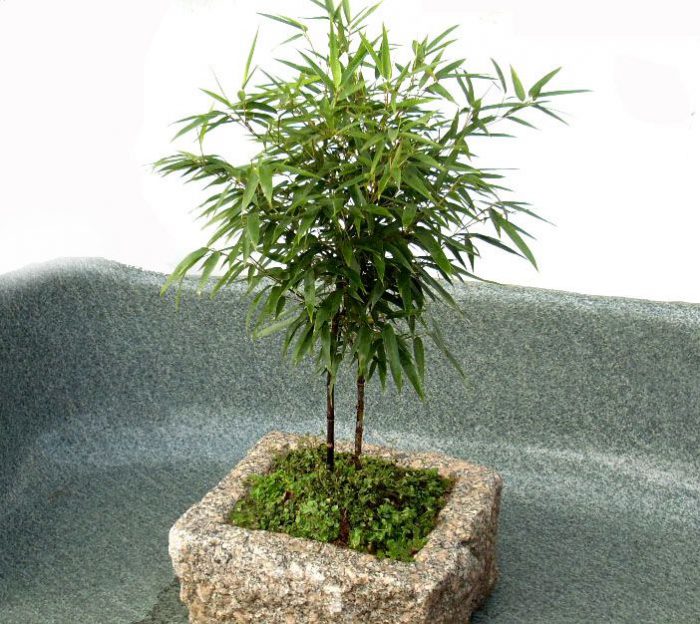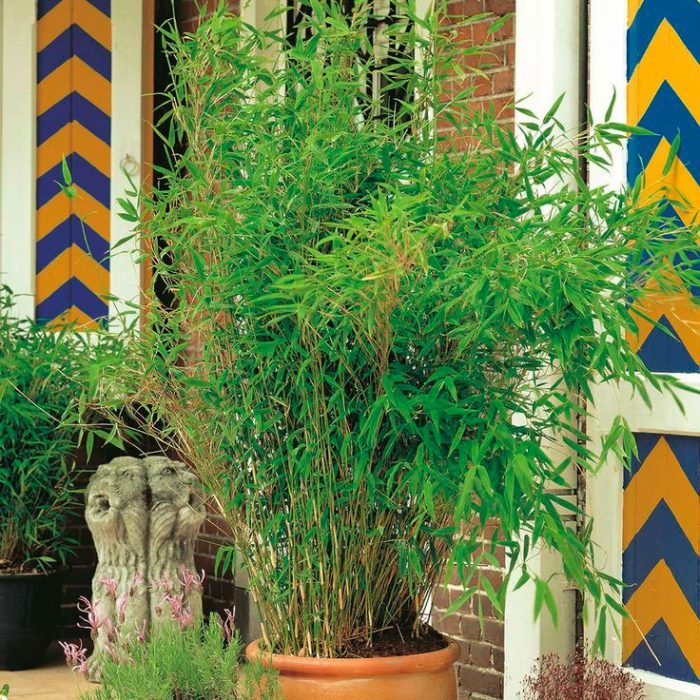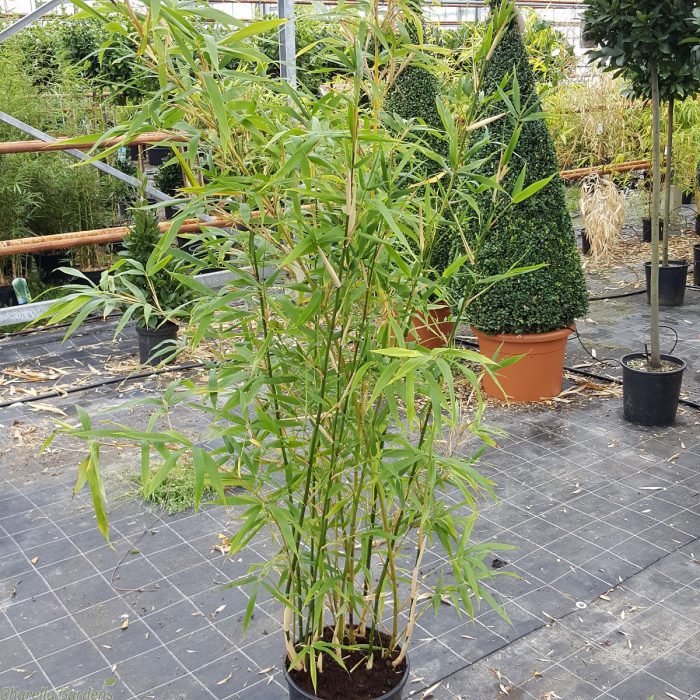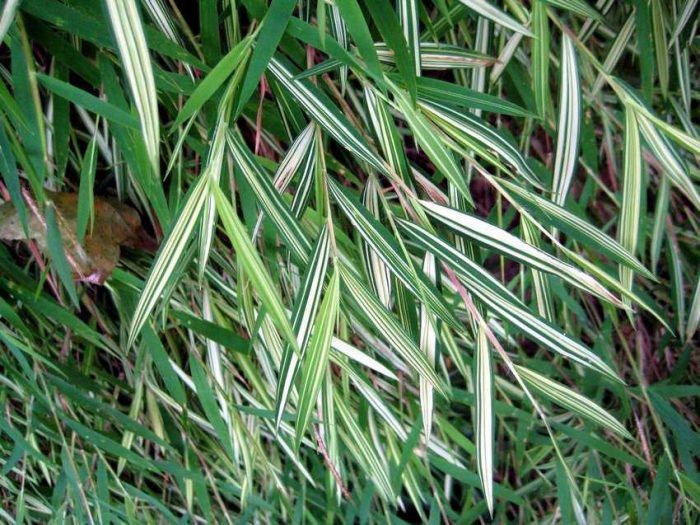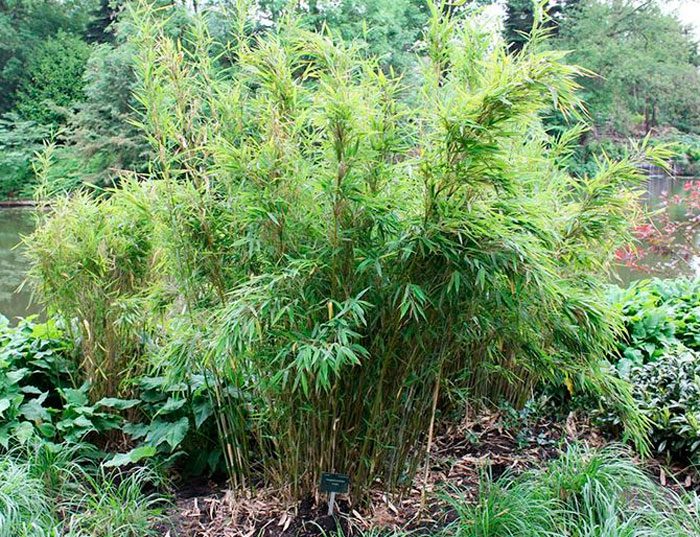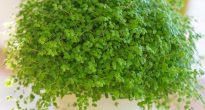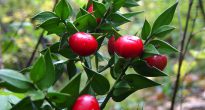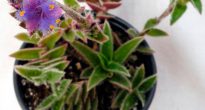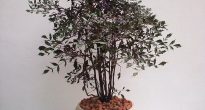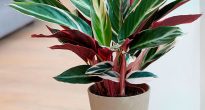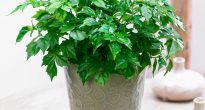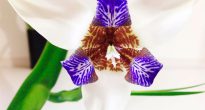An ornamental leafy plant like arundinaria (Arundinária) is a perennial and is directly related to the cereal family. This plant comes from Japan and China, but now it can be found in natural conditions in Western Europe and the United States. It is also called reed or indoor bamboo. This genus includes 20 different species. Some of them are very popular with florists and gardeners. Depending on the species, the height of arundinaria can vary from 0.5 to 8 meters. At home, as a rule, only dwarf species are grown, the height of which varies from 0.4 to 3 meters.
Such a plant has hard, belt-shaped leaves that adjoin the base of the shoot. In the process of growth, such leaf plates gradually bend away from the shoot and become drooping. These leaves are not very large in size, and they also have a petiole. On their surface there is a clearly visible pattern of veins. The color of the shoots and foliage directly depends on the species, and can be of any shade from silver to purple, dark green or cream. Drooping or creeping (with nodes and internodes) shoots that form a bush or thickets grow directly from the rhizome. The inner part of the stems is hollow, and the shoot itself is tree-like to the touch. Due to these characteristics, the stems are widely used in the creation of toys, as well as hedges.
A brush-shaped inflorescence (paniculate) bears small flowers. Spikelets are long, loose, one-flowered.
Content
- 1 Home care for arundinaria
- 2 Main types
- 2.1 Arundinaria appalachiana (Arundinaria appalachiana)
- 2.2 Arundinaria fargesii (Arundinaria fargesii)
- 2.3 Arundinaria simoni (Arundinaria simoni)
- 2.4 Green-striped Arundinaria (Arundinaria viridi-striata)
- 2.5 Arundinaria brilliant (Arundinaria nitida)
- 2.6 Arundinaria variegated (Arundinaria variegata)
- 2.7 Arundinaria murielae
- 2.8 Arundinaria giant (Arundinaria gigantea)
Home care for arundinaria
Arundinaria is a tropical plant, in this regard, it needs to try to create conditions close to natural. The greatest difficulty for flower growers in caring for such a plant is the correct wintering, since the required temperature should be at around 6-8 degrees.
Temperature regime
The optimum temperature in summer is from 18 to 20 degrees, and in winter - about 10 degrees (preferably from 6 to 8 degrees). At a high (more than 15 degrees) room temperature in winter, such a plant begins to grow worse.Wintering in a warm place depletes arundinaria, which can lead to its death. In the summer, experts advise to move the plant outside. It is also necessary to systematically ventilate the room where it is located.
Humidity
Under natural conditions, such a plant prefers to grow on lake and river banks, in marshy lowlands. But despite this, in room conditions, it does not need high humidity. Experienced flower growers recommend that the need for air humidity in arundinaria should be determined empirically. So, if at low humidity it grows and develops normally, then moistening with a sprayer can rarely be carried out. If the air humidity is too low, then you need to spray the foliage every day. Only soft water is suitable for this purpose.
How to water
In spring and summer you need to water 2 or 3 times every 7 days. The soil in the pot should be moist at all times. The earthen ball should never dry out completely. In winter, watering is severely limited. So, at this time, it is recommended to water the plant only after the top layer of the substrate has thoroughly dried.
Fertilizer
Top dressing is carried out systematically 1 or 2 times a month. For this, mineral fertilizers are used. To improve the growth and development of young specimens, phosphorus-containing fertilizers are used, and nitrogen-containing fertilizers are used to increase the amount of foliage. An adult specimen needs rather rare dressings, which are produced only if the plant has signs of nutritional deficiency. In autumn and winter, fertilizers are not applied to the soil.
Important! Such a plant blooms only once and this, as a rule, occurs at 33 years of age. After flowering ends, the bush dies.
Illumination
Such a plant should be protected from direct sunlight. It grows best in diffused lighting or partial shade. In this regard, it is recommended to place it on a north or east orientation window. If you put it on the west or south window, you will need shading from the scorching midday sun rays.
Location
Arundinaria feels best in a room of western and eastern orientation. It can also be placed in a southern room, but it should be cool. She will feel great in the greenhouse, on the veranda or in the foyer of the institution.
Earth mix
You can buy commercial potting soil for palm trees, for dracaena, or for dracaena and yucca. The most suitable soil should have a pH of 6.8. To prepare the soil mixture, it is necessary to combine compost and clay-turf soil, as well as sand in equal parts. It is recommended to add a little leafy earth.
Reproduction methods
It can be propagated by dividing the rhizome, while this procedure is recommended to be carried out during the transplantation process. You can also root cuttings that are obtained by pruning a bush. However, remember that pruning is not necessary.
Green cuttings are cut in summer or spring. They are planted in the soil, while it is necessary to provide the bottom heating of the container. These cuttings need warmth and high humidity.
The rhizome freed from the soil should be divided with a sharp knife into the required number of divisions. After that, each piece is planted in a separate container filled with a moistened earth mixture. Cover the stalk with a transparent bag and place in a well-lit and warm place. You need to remove the shelter after 2 or 3 days.
Transplant features
The plant is transplanted in the spring, as a rule, once every 2 or 3 years. You can transplant only when necessary, for example, when the roots fill the entire container. It is recommended to transplant the flower by the transshipment method without disturbing the earthen ball. A wide and not too high pot is suitable for planting.
Care Tips
Basic tips for grooming:
- systematic loosening of the upper layer of the substrate;
- wiping sheet plates from dust as needed;
- a suitable container should be wide and low;
- it is recommended to grow in a spacious room.
Interesting! In the United States, the east coast has become a site of widespread distribution of such a plant, which greatly worries local residents.
Possible problems
The main problems with growing:
- the leaves become faded, turn yellow, and the shoots stretch out - poor lighting;
- leaf plates become faded, turn yellow and curl - poor watering;
- drooping and drooping foliage - stagnation of water in the substrate;
- the appearance of rot on the roots - as a rule, this can happen in winter with excessively abundant watering;
- the tips of the leaves turn yellow and dry - too dry air.
The foliage can settle whitefly and spider mites.
Main types
Arundinaria appalachiana (Arundinaria appalachiana)
This species has become known only recently. In nature, such a plant can be found in North America in the Appalachian Mountains. It is also called mountain reed. The bush is usually not very tall, but rather bushy. It is often used as a ground cover plant. Grows best in partial shade of large garden plants. It grows very rarely at home.
Arundinaria fargesii (Arundinaria fargesii)
This plant comes from China. It has a very effective appearance, but it is more popular with gardeners than with florists. Under natural conditions, it reaches a height of 10 m, and when grown in a house - from 80 to 100 centimeters. Shiny, smooth, belt-like leaves are rather tough to the touch. When grown outdoors, a whitish bloom or chaotically located spots of a silvery color appear on the surface of the foliage. This plant branches quite strongly, due to which it forms a very lush bush, which looks extremely impressive. Young shoots of such arundinaria also have a very attractive appearance due to their reddish-brown color.
Arundinaria simoni (Arundinaria simoni)
Such a plant is a perennial. Its rhizome goes deep enough into the soil. Shoots can reach a height of 6 m. On the surface of the shoots there is a coating of wax. They are cylindrical, straight and have protruding nodes. The plant branches quite strongly. Rather large leaf plates, painted in dark green, have a lanceolate or lanceolate shape. Inflorescences have racemose or panicle shape and consist of single-flowered, long and rather loose ears.
Green-striped Arundinaria (Arundinaria viridi-striata)
The shoots are purple-green. The leaf plates reach 18 centimeters in length, and stripes of yellow color flaunt on their surface. It has a height of about 150 centimeters.
Arundinaria brilliant (Arundinaria nitida)
Narrow leaves can be up to 10 centimeters long. The shoots are purple in color. Shoot height can be up to 300 centimeters.
Arundinaria variegated (Arundinaria variegata)
This species is most suitable for indoor cultivation. The leaves can be up to 100 centimeters long, and they have a very effective appearance.
Arundinaria murielae
This species is similar to the brilliant arundinaria, but this plant has yellow shoots.
Arundinaria giant (Arundinaria gigantea)
Homeland are the southeastern regions of the United States. The diameter of the stems in natural conditions is 7 cm, while in height they can reach 10 m. Young shoots are slightly lignified, but as they grow, they become completely lignified. Cylindrical shoots are hollow inside. The plant is highly branched, due to which it is able to form dense thickets. The length of the leaf plates varies from 10 to 30 centimeters, and the width is from 2.5 to 4 centimeters. They have a rounded base and pointed tips. This species is frost-resistant, it is not afraid of temperature drops to minus 30 degrees, while the leaves do not fall off in winter.
Interestingly, with age, the stems completely lignify and become similar to bamboo.


